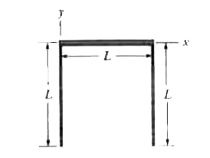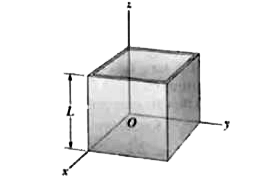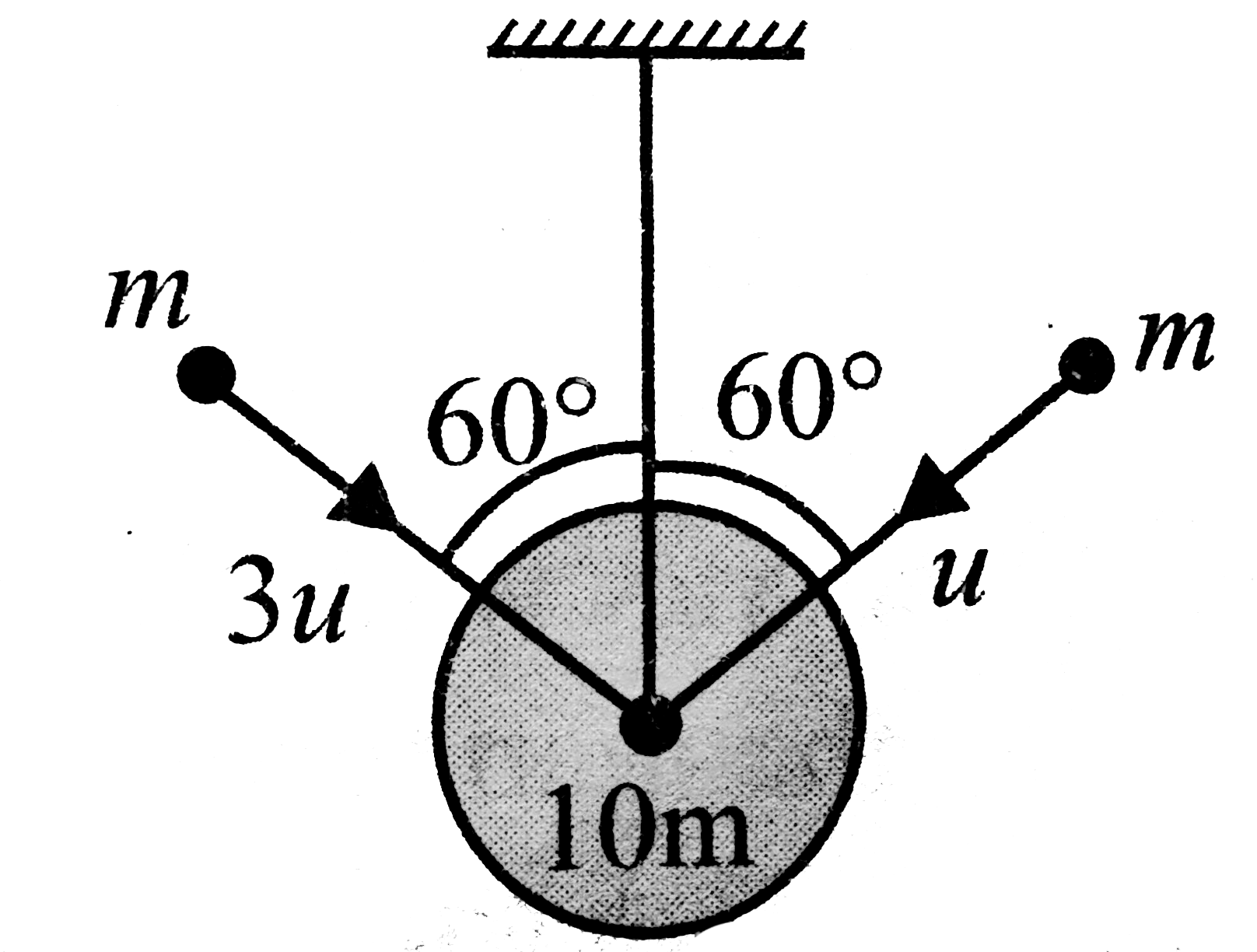Problems from RESNICK AND HALLIDAY PHYSICS (HINGLISH) CENTER OF MASS for Class 12
| Class 12 | PHYSICS |
| Chapter | CENTER OF MASS |
| RESNICK AND HALLIDAY PHYSICS (HINGLISH) | Problems |
| Medium | English |
| Academic Year | 2023-2024 |
Question 4
A 1000 kg automobile is at rest at a traffic signal. At the instant the light turns green, the auto mobile starts to move with a constant acceleration of 3.0m/s2. At the same instant a 2000 kg truck, traveling at a constant speed of 8.0 m/s, overtakes and passes the automobile. (a) How far is the com of the automobile-truck system from the traffic light at t = 5.0 s? (b) What is the speed of the com then?View SolutionQuestion 5
A big olive (m=0.50 kg) lies at the origin of an xy coor dinate system, and a big Brazil nut (M = 1.5 kg) lies at the point (1.0,2.0) m. At t=0, a force →Fo=(2.0ˆi+3.0ˆj)N begins to act on the olive, and a force →Fn=(−3.0ˆi–2.0ˆj)N begins to act on the nut. In unit-vector notation, what is the displacement of the center of mass of the olive-nut system at t = 4.0 s, with respect to its position at 1= 0?View SolutionQuestion 7
Richard, of mass 80 kg, and Camelia, who is lighter, are in a 30 kg canoe on a lake. When the canoe is at rest in the placid water, they exchange seats, which are 3.0 m apart and symmetrically located with respect to the canoe's center. If the canoe moves 45 cm horizontally relative to a pier post, what is Camelia's mass?View SolutionQuestion 9
A ball of mass 50 g moving at a speed of 2.0 m/s strikes a plane surface at an angle of incidence 450. The ball is reflected by the plane at an equal angle of reflection with the same speed. Calculate (a). the magnitude of the change in momentum of the ball (b). the change in the magnitude of the mometum of the ball.View SolutionQuestion 10
In February 1955, a paratrooper fell 370 m from an air plane without being able to open his chute but happened to land in snow. suffering only minor injuries. Assume that his speed at impact was 56 m/s (terminal speed), that his mass (including gear) was 85 kg, and that the magnitude of the force on him from the snow was at the survivable limit of 1.2×105 N. What are (a) the minimum depth of snow that would have stopped him safely and (b) the magnitude of the impulse on him from the snow?View SolutionQuestion 12
In a common but dangerous prank, a chair is pulled away as a person is moving downward to sit on it, causing the victim to land hard on the floor. Suppose the victim falls by 0.50 m, the mass that moves downward is 75 kg, and the collision on the floor lasts 0.088 s. What are the magnitudes of the (a) impulse and (b) average force acting on the victim from the floor during the collision?View SolutionQuestion 13
A 3.0kg block slides on a frictionless horizontal surface, first moving to the left at 50m/s. It collides with a spring as it moves left, compresses the spring and is brought to rest momentarily. The body continues to be accelerated to the right by the force of compressed spring. Finally, the body moves to the right at 40m/s. The block remains in contact with the spring for 0.020s. What were the magnitude and direction of the impulse of the spring on the block? What was the spring's average force on the block?View SolutionQuestion 14
In tae-kwon-do, a hand is slammed down onto a target at a speed of 13 m/s and comes to a stop during the 5.5 ms collision. Assume that during the impact the hand is independent of the arm and has a mass of 0.70 kg. What are the magnitudes of the (a) impulse and (b) average force on the hand from the target?View SolutionQuestion 16
Jumping up before the elevator hits. After the cable snaps and the safety system fails, an elevator cab free-falls from a height of 36 m. During the collision at the bottom of the elevator shaft, a 90 kg passenger is stopped in 5.0 ms. (Assume that neither the passenger nor the cab rebounds.) What are the magnitudes of the (a) impulse and (b) average force on the passenger during the collision? If the passenger were to jump upward with a speed of 7.0 m/s relative to the cab floor just before the cab hits the bottom of the shaft, what are the magnitudes of the (c) impulse and (d) average force (assuming the same stopping time)?View SolutionQuestion 17
Figure shows a 0.300 kg baseball just before and just after it collides with a bat. Just before, the ball has velocity →v1 of magnitude 12.0 m/s and angle θ1=35.0∘ Just after, it is traveling directly upward with velocity →v2 of magnitude 10.0 m/s The duration of the collision is 2.00 ms. What are the (a) magnitude and (b) direction (relative to the positive direction of the x axis) of the impulse on the ball from the bat? What are the (c) magnitude and (d) direction of the average force on the ball from the bat?
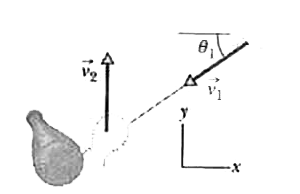 View Solution
View SolutionQuestion 18
A 0.25 kg puck is initially stationary on an ice surface with negligible friction. At time t = 0, a horizontal force begins to move the puck. The force is given by →F=(12.0−3.00t2)ˆi, with →F in newtons and t in seconds, and it acts until its magnitude is zero. (a) What is the magnitude of the impulse on the puck from the force between t= 0.750 s and t = 1.25 s? (b) What is the change in momentum of the puck between t=0 and the instant at which F=0?View SolutionQuestion 21
A space vehicle is traveling at 4800 km/h relative to Earth when the exhausted rocket motor (mass 4m) is disengaged and sent backward. The relative speed between motor and command module (mass m) is then 82 km/h. What is the speed of the command module relative to Earth just after the separation ?View SolutionQuestion 22
A 15.0 kg package is moving at a speed of 10.0 m/s vertically upward along a y axis when it explodes into three fragments: a 2.00 kg fragment is shot upward with an initial speed of 20.0 m/s and a 3.00 kg fragment is shot in the positive direction of a horizontal x axis with an initial speed of 5.00 m/s. Find (a) the speed of the third fragment right after the explosion and (b) the total kinetic energy provided by the explosion.View SolutionQuestion 23
In Fig. a stationary block explodes into two pieces L and R that slide across a frictionless floor and then into regions with friction, where they stop. Piece L. with a mass of 2.0 kg, encounters a coefficient of kinetic friction μL = 0.35 and slides to a stop in distance dL =0.15 m. Piece R encounters a coefficient of kinetic friction μR=0.50 and slides to a stop in distance dR =0.30 m. What was the mass of the block?
 View Solution
View SolutionQuestion 25
Particle A and particle B are held together with a compressed spring between them. When they are released, the spring pushes them apart, and they then fly off in opposite directions, free of the spring. The mass of A is 2.00 times the mass of B, and the energy stored in the spring was 80 J. Assume that the spring has negligible mass and that all its stored energy is transferred to the particles. Once that transfer is complete, what are the kinetic energies of (a) particle A and (b) particle B?View SolutionQuestion 27
A 5.20 g bullet moving at 700 m/s strikes a 700 g wooden block at rest on a frictionless surface. The bullet emerges, traveling in the same direction with its speed reduced to 450 m/s. (a) What is the resulting speed of the block? (b) What is the speed of the bullet-block center of mass ? View SolutionQuestion 28
A completely inelastic collision occurs between two balls of wet putty that move directly toward cach other along a vertical axis. Just before the collision, one ball, of mass 3.0 kg, is moving upward at 20 m/s and the other ball, of mass 2.0 kg, is moving downward at 10 m/s. How high do the combined two balls of putty rise above the collision point? (Neglect air drag.)View SolutionQuestion 29
Block A has a mass 3kg and is sliding on a rough horizontal surface with a velocity uA=2m/s when it makes a direct collision with block B, which has a mass of 2kg and is originally at rest. The collision is perfectly elastic. Determine the velocity of each block just after collision and the distance between the blocks when they stop sliding. The coefficient of kinetic friction between the blocks and the plane is μk=0.3 ( Take g=10m/s2)View SolutionQuestion 30
In the "before" part of Fig., car A (mass 1100 kg) is stopped at a traffic light when it is rear-ended by car B (mass 1400 kg). Both cars then slide with locked wheels until the frictional force from the slick road (with a low μk of 0.10) stops them, at distances dA = 8.2 m and dB = 6.1 m. What are the speeds of (a) car A and (b) car B at the start of the sliding, just after the collision? (c) Assuming that linear momentum is conserved during the collision, find the speed of car B just before the collision. (d) Explain why this assumption may be invalid.
 View Solution
View SolutionQuestion 31
In Fig. , a ball of mass m = 60 g is shot with speed vi = 22 m/s into the barrel of a spring gun of mass M= 240 g initially at rest on a frictionless surface. The ball sticks in the barrel at the point of maximum compression of the spring. Assume that the increase in thermal energy due to friction between the ball and the barrel is negligible. (a) What is the speed of the spring gun after the ball stops in the barrel? (6) What fraction of the initial kinetic energy of the ball is stored in the spring?
 View Solution
View SolutionQuestion 32
Two titanium spheres approach each other head-on with the same speed and collide elastically. After the collision, one of the spheres, whose mass is 250 g, remains at rest. (a) What is the mass of the other sphere? (b) What is the speed of the two sphere center of mass if the initial speed of each sphere is 2.00 m/s?View SolutionQuestion 33
Block 1 of mass m1 slides along a frictionless floor and into a one-dimensional elastic collision with stationary block 2 of mass m2=3m1. Prior to the collision, the center of mass of the two block system had a speed of 3.00 m/s. Afterward, what are the speeds of (a) the center of mass and (b) block 2 ? View SolutionQuestion 34
Particle 1 with mass m and velocity v and particle 2 with mass 2m and velocity -2v are moving toward each other along an x axis when they undergo a one-dimensional elastic collision. After the collision, what are the velocities of (a) particle 1 and (b) particle 2? What is the velocity of the center of mass of the two-particle system (c) before and (d) after the collision?View SolutionQuestion 35
Block 1, with mass m1 and speed 3.0 m/s, slides along an x axis on a frictionless floor and then undergoes a one dimensional elastic collision with stationary block 2, with mass m2=0.40m1. The two blocks then slide into a region where the coefficient of kinetic friction is 0.50, there they stop. How far into that region do (a) block 1 and (b) block 2 slide?View SolutionQuestion 36
In Fig., particle 1 of mass m1 = 0.30 kg slides rightward along an x axis on a frictionless floor with a speed of 2.0 m/s. When it a one-dimensional elastic collision with stationary particle 2 of mass m2 = 0.40 kg. When particle 2 then reaches a wall at xw = 70 cm, it bounces from the wall with no loss of speed. At what position on the x axis does particle 2 then collide with particle 1 ?
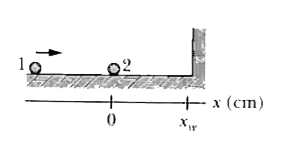 View Solution
View SolutionQuestion 37
In Fig. , block 1 of mass m1 slides from rest along a frictionless ramp from height h = 3.00 m and then collides with stationary block 2, which has mass m2=2.00m1. After the collision, block 2 slides into a region where the coefficient of kinetic friction μk is 0.450 and comes to a stop in distance d within that region. What is the value of distance d if the collision is (a) elastic and (b) completely inelastic?
 View Solution
View SolutionQuestion 38
A small ball of mass m is aligned above a larger ball of mass M = 0.63 kg (with a slight separation, as with the baseball and basket ball of Fig. ), and the two are dropped simultaneously from a height of h = 1.8 m. (Assume the radius of each ball is negligible relative to h.) (a) If the larger ball rebounds elastically from small ball rebounds elastically from the larger ball, what value of m results in the larger ball stopping when it collides with the small ball ? (b)What height does the small ball then reach ?
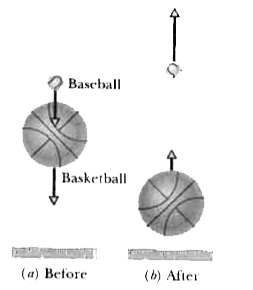 View Solution
View SolutionQuestion 39
In Fig. puck 1 of mass m1 = 0.25 kg is sent sliding across a frictionless lab bench, to undergo a one-dimensional elastic collision with stationary puck 2. Puck 2 then slides off the bench and lands a distance d from the base of the bench. Puck 1 rebounds from the collision and slides off the opposite edge of the bench, landing a distance 2d from the base of the bench. What is the mass of puck 2?
 View Solution
View SolutionQuestion 40
In the two-dimensional collision in Fig., the projectile particle has mass m1=m, initial speed vu=3v0, and final speed v1f=√5v0. The initially stationary target particle has mass m1 = 2m and final speed v2f=v2. The projectile is scattered at an angle given by tan θ1 =2.0. (a) Find angle θ2. (b) Find v2 in terms of v0 .(c) Is the collision elastic?View SolutionQuestion 42
A force →F acts on two particles of masses m and 4.0m moving at the same speed but at right angles to each other, as shown in Fig. The force acts on both the particles for a time T. Consequently, the particle of mass m moves with a velocity 4v in its original direction. (a) Find the new velocity v' of the other particle. (b) Also find the change in the kinetic energy of the system.
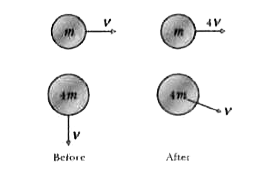 View Solution
View SolutionQuestion 45
Consider a rocket that is in deep space and at rest relative to an inertial reference frame. The rocket's engine is to be fired for a certain interval. What must be the rocket's mass ratio (ratio of initial to final mass) over that interval if the rocket's original speed relative to the inertial frame is to be equal to (a) the exhaust speed (speed of the exhaust products relative to the rocket) and (b) 2.0 times the exhaust speed?View SolutionQuestion 46
(a) A rocket set for vertical firing weighs 50kg and contains 450kg of fuel. It can have a maximum exhaust velocity of 2km/s. What should be its minimum rate of fuel consumption
(i) to just lift off the launching pad?
(ii) to give it an initial acceleration of 20m/s2?
(b) What will be the speed of the rocket when the rate of consumption of fuel is 10kg/s after whole of the fuel is consumed? (Take g=9.8m/s2)View Solution

